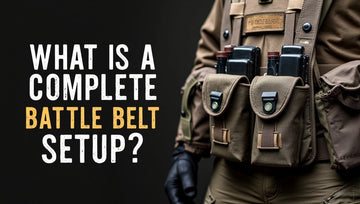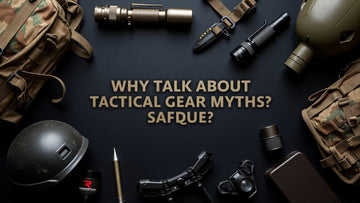Tactical vests have become a staple in both military operations and recreational sports like airsoft and paintball. Once developed solely for battlefield armor and ballistic protection, these versatile load-bearing systems have evolved into lightweight, modular gear suited for diverse environments.
Understanding the evolution of tactical vests offers insight into how technological innovation, user demand, and material science have transformed military-grade body armor vests into airsoft tactical gear that anyone can wear.
In this article, we’ll explore the journey of the tactical vest—starting from its military origins with soft armor vests and plate carriers, all the way to modern airsoft vests used for sport and training.
Load-Bearing Origins in the Military
The story of the tactical vest begins with early 20th-century military innovations in load-bearing gear. During World War I and World War II, soldiers relied on basic webbing systems such as the ALICE (All-Purpose Lightweight Individual Carrying Equipment) and earlier strap-based rigs. These setups weren’t exactly comfortable or efficient, but they provided a way to carry essential ammunition, grenades, water, and medical supplies.
The primary purpose of these early military tactical vests was functionality, not protection. Soldiers needed to move quickly and efficiently in various combat zones.
While these early vests lacked the ballistic protection offered by modern designs, they set the foundation for what would become today’s modular tactical plate carriers.
These primitive load-bearing systems were the starting point in the long journey toward the high-tech modular tactical systems used by today’s armed forces and airsoft enthusiasts alike.
WWII & the Flak Jacket Breakthrough
World War II marked a turning point in battlefield armor with the development of the flak jacket. Originally created for bomber crews, these heavy vests were designed to protect against shrapnel— “flak”—from anti-aircraft artillery. Made from layered nylon and steel plates, these vests were far from light, but they offered much-needed protection in high-risk roles.
The body armor vest gained popularity across different branches of the military, particularly for airborne divisions and artillery units. While they weren’t rated to stop bullets, flak jackets dramatically reduced injury from blasts and debris.
This early innovation in soft armor vest design influenced future developments in both material choice and tactical load layout.
Kevlar Body Armor & the Rise of Protection
In the 1970s, Kevlar body armor revolutionized personal protection for soldiers and law enforcement. Developed by DuPont, Kevlar is a lightweight yet incredibly strong synthetic fiber capable of absorbing and dispersing impact energy. This ushered in a new era of soft armor vests that could stop certain handgun rounds and reduce shrapnel damage.
Unlike the heavy flak jackets of WWII, these vests offered a more balanced solution between protection and wearability. Ballistic protection became practical for soldiers on foot patrols, police officers, and even private contractors. These vests also featured improved ventilation and flexibility, which helped reduce fatigue during long missions.
During this era, body armor vests began incorporating modular tactical systems that allowed interchangeable panels and added storage. Soldiers could attach pouches, communication gear, and medical kits, paving the way for the fully modular setups seen in today’s MOLLE tactical vests.
The MOLLE System & Modular Gear
The 1990s brought the most dramatic transformation yet: the MOLLE (Modular Lightweight Load-Carrying Equipment) system. Built upon the PALS (Pouch Attachment Ladder System) webbing, MOLLE gave soldiers unprecedented flexibility in customizing their military tactical vest setups.
Each MOLLE tactical vest is equipped with rows of webbing that allow the user to attach pouches, hydration packs, radios, or even extra armor plates. The MOLLE system also laid the groundwork for airsoft tactical gear. While airsoft vests don’t provide ballistic protection, they offer the same functionality in terms of pouch arrangement and gear access—perfect for simulating real-world conditions.
The modularity of MOLLE extended into other sports as well. Paintball vests and even hunting vests adopted similar webbing systems, allowing players to carry extra rounds, hydration systems, or emergency kits with ease.
Whether in combat zones or weekend skirmishes, users can now build their vest around their mission. This adaptability continues to define both military and airsoft plate carriers today.
Advanced Plate Carriers: IOTV, MTV, MSV
In the 2000s, military plate carriers saw significant upgrades. The Interceptor Body Armor (IBA) was replaced by the Improved Outer Tactical Vest (IOTV) in 2007, designed for better weight distribution, side protection, and quick-release capabilities. Marines adopted the Modular Tactical Vest (MTV) in 2006, and later, the Modular Scalable Vest (MSV) brought even more mobility and adjustability.
These advanced tactical vests featured hard armor plates that could stop rifle rounds and absorb high-impact trauma. Some also included soft armor inserts, side protection, and integrated communication gear. The inclusion of quick-release tactical vest systems became a major safety innovation, allowing soldiers to remove the vest rapidly in emergencies.
Today's plate carriers are designed for adaptability, ergonomics, and survivability. They accommodate MOLLE-compatible attachments, night-vision battery packs, medical gear, and more.
Civilian Use & Airsoft Tactical Vests
The transition from battlefield to backyard became a reality as tactical gear made its way into civilian sports like airsoft, paintball, and hunting. Today’s airsoft vests are designed to look and function much like their military counterparts, excluding the ballistic protection.
Modern airsoft tactical gear uses high-durability materials such as polyester or 1000D nylon to ensure gear holds up during intense matches. Modular configurations, MOLLE webbing, and adjustable fits have made these vests highly customizable—even for beginners.
Though airsoft vests do not come with IR coatings or hard armor plates, the realism and utility they offer is unmatched in recreational sports.
Comparing Military vs Airsoft Tactical Vests
While military plate carriers and airsoft vests may look similar, there are crucial differences in build, function, and purpose.
Military tactical vests are made from IR-treated, high-tensile nylon and reinforced stitching to endure extreme conditions. They often include hard armor plates and are tested for ballistic protection against real threats.
In contrast, airsoft tactical vests prioritize weight and mobility. Most are made from polyester, mesh, or mid-grade nylon, making them lighter and more breathable—perfect for extended gameplay.
Future Trends in Tactical Vest Design
The next generation of tactical vests will emphasize smart features, lighter materials, and sustainable practices. Military R&D teams are already exploring load-bearing exoskeletons, integrated comms systems, and heat-reducing textiles.
For civilian markets, especially airsoft tactical gear, the future points to improved breathability, faster quick-release mechanisms, and better weight distribution. We’ll likely see lightweight tactical vests with smart fabrics that wick moisture and provide temperature control.
Conclusion
The evolution of tactical vests mirrors the ever-changing demands of combat, law enforcement, and sport. From the flak jackets of World War II to today’s modular MOLLE tactical vests and airsoft plate carriers, each advancement has balanced protection, performance, and practicality.
At Redemption Tactical, we craft high-performance gear built to last—without the inflated price tags. Get the quality you need at prices you’ll appreciate.
Visit us and shop now to gear up smart and perform more.
FAQs (Frequently Asked Questions)
Q1: What is the difference between a military plate carrier and an airsoft vest?
A: Military plate carriers are designed for combat and include ballistic protection using hard armor plates. Airsoft vests mimic their design but focus on mobility and affordability, often using lightweight materials like polyester.
Q2: Are airsoft tactical vests durable?
A: Yes. While they lack bullet resistance, many airsoft vests are made from rugged nylon or CORDURA to withstand gameplay stress. They feature MOLLE webbing and adjustable straps for a reliable fit.
Q3: What is a MOLLE system in tactical gear?
A: MOLLE (Modular Lightweight Load-Carrying Equipment) allows users to attach pouches and accessories using PALS webbing. It’s standard in both military tactical vests and airsoft gear for custom loadouts.
Q4: Can you use a military tactical vest for airsoft?
A: Yes, but it’s often heavier than needed. Military vests include armor and IR treatments that aren’t necessary for recreational play. Many opt for lightweight tactical vests designed specifically for airsoft.
Q5: What should I look for in an airsoft vest?
A: Key features include modular tactical systems, MOLLE compatibility, adjustable fit, breathable materials, and enough pouch space.






